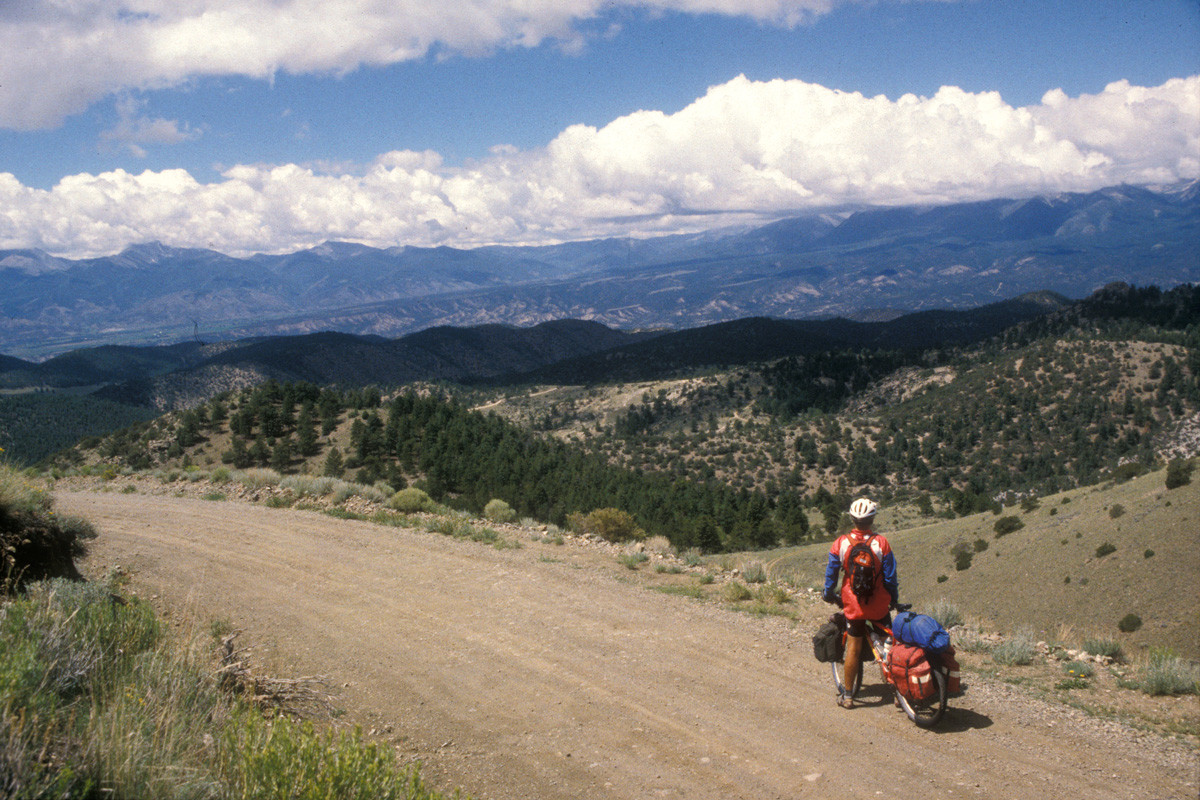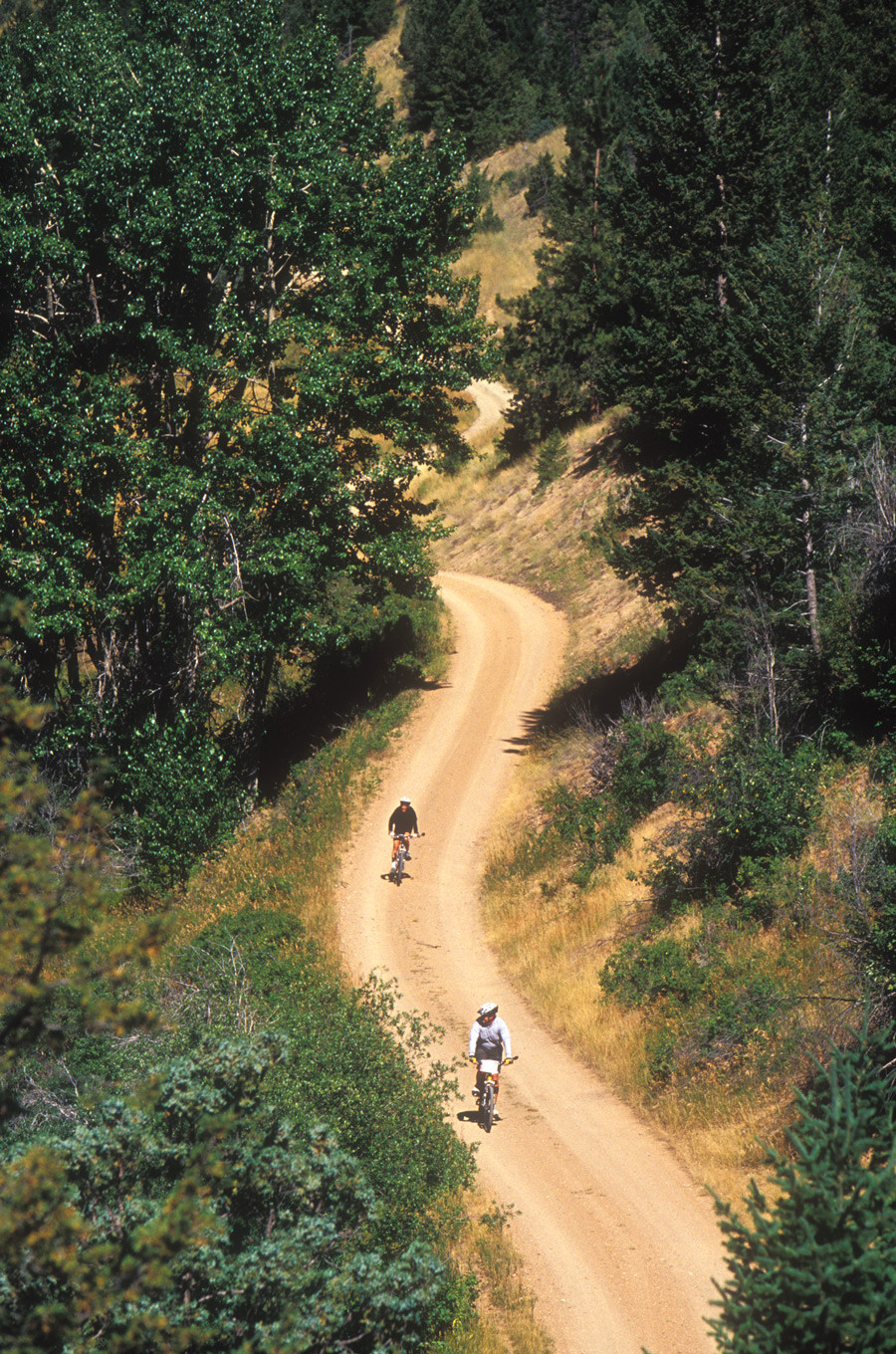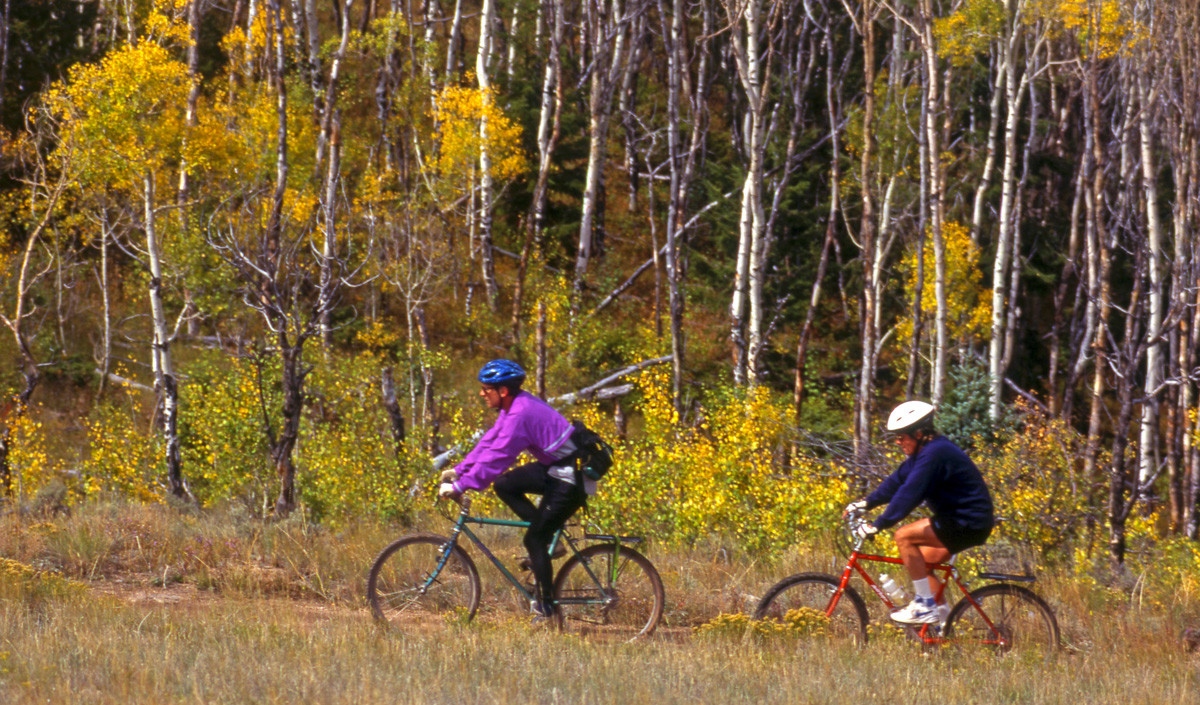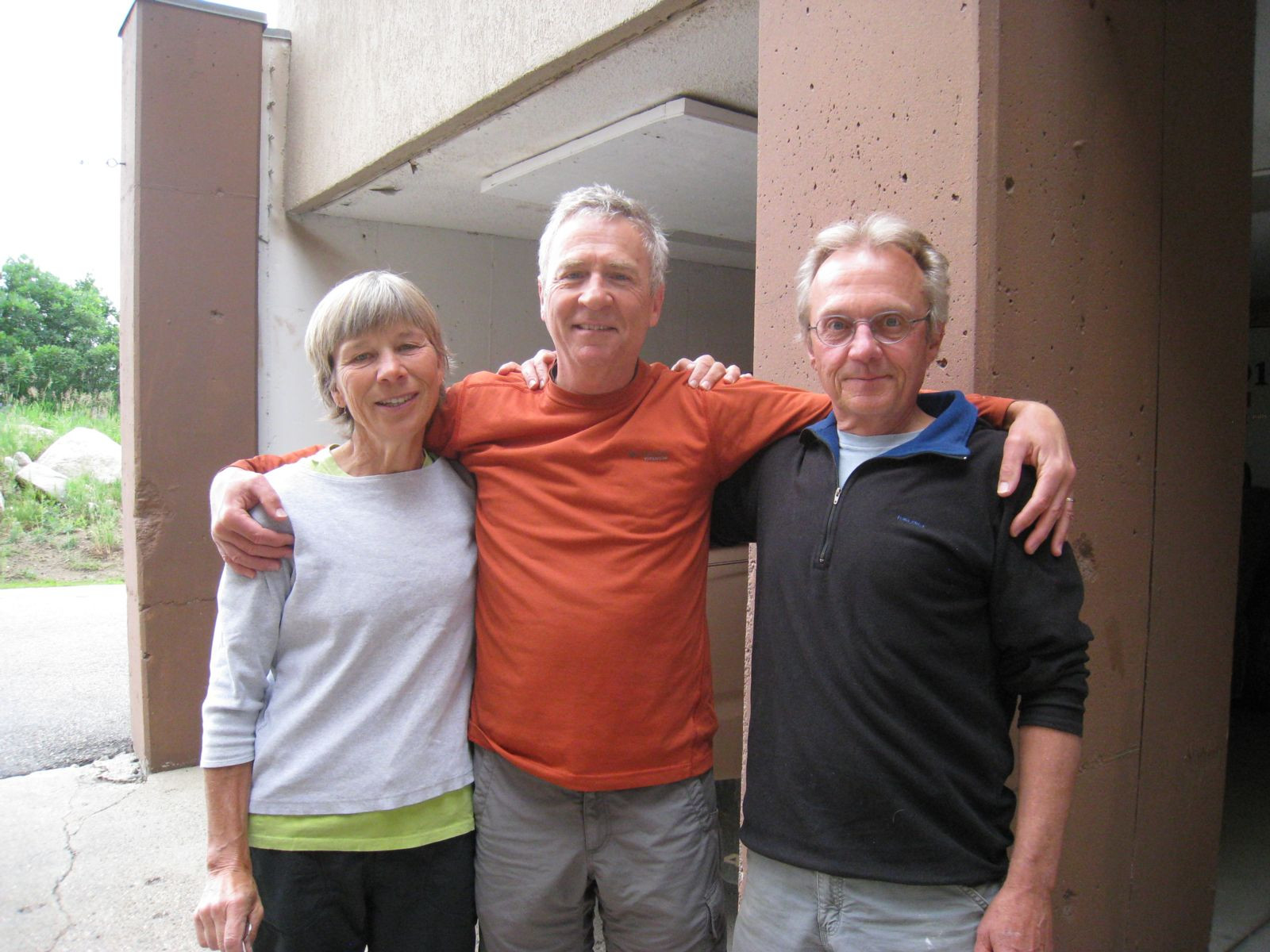Tour Divide racers experience a rollercoaster of emotions as they tackle the grueling 2,700 miles between Banff and Antelope Wells. This reality is echoed in the experiences of those who conceived and mapped the routes themselves. Having spoken with racers, followed their mid-race reports, watched Ride the Divide, and drawn upon my own endurance experiences in marathon running and cross-country skiing, I understand the profound mental and physical demands of pushing personal limits for extended periods.
Similar to a Tour Divide racer, the journey of planning, researching, and mapping the Great Divide Mountain Bike Route was an emotional rollercoaster. Over two and a half to three years, feelings swung dramatically from moments of apprehension to bursts of hope and pure elation.
Here are some reflections on the emotional landscape of creating this iconic route, a testament to the genesis of mountain bike touring as we know it.
Inspiration: The Spark of an Idea
On July 20, 1985, a trip with my college friend Ramon, a geologist in Wyoming, and my wife Nancy ignited the flame. Ramon dropped us off at the Tri-Basin Divide in southwest Wyoming—a geographical marvel where water flows towards the Colorado River, the Columbia River, or the Great Basin. Equipped with our Cannondale mountain bikes, among the first fat-tire bikes sold in Missoula, Montana, we embarked on a five-day camping adventure. Our bikes, laden with too much gear in rear panniers, became our steeds as we explored dirt roads and trails through the Wyoming and Salt River ranges, venturing into the Green River valley and along the Gros Ventre River from its source to its confluence with the Snake River in Jackson Hole. The trip was challenging, exhilarating, and transformative. It was during this journey that I discovered a new passion, a deep-seated love for mountain bike exploration, the genesis of what would become a life’s work.
 Cyclist on the Great Divide Mountain Bike Route
Cyclist on the Great Divide Mountain Bike Route
Nine years later, the dream took a more concrete form. In the July 1994 issue of Adventure Cyclist (formerly BikeReport), I authored a two-page spread headlined: “Ready for the Longest Mountain Bike Trail in the World?”
The article opened with a compelling vision: “Imagine mountain biking from Canada to Mexico, through some of the most stunning landscapes on earth, along dirt roads and two-tracks reserved for the occasional fisherman’s rig, Forest Service pickup truck … and Adventure Cycling mountain biker.”
The story detailed the origins of our ambition to create an off-pavement route paralleling the Continental Divide and our motivation to realize it: “Historically, cycling enthusiasts have leaned towards either fully loaded pannier touring on paved roads or day rides on mountain bikes in the hills. Few had combined the two for fully supported off-pavement touring. We wanted to change that, to usher in a new era for mountain bike adventure, the genesis of a new style of long-distance riding.”
Appreciation for Precursors: Standing on the Shoulders of Giants
The Great Divide’s inception was not in a vacuum. It owes a debt to pioneers like Mike and Dan Moe of Laramie, Wyoming, brothers who undertook a groundbreaking hike-a-bike expedition along the Continental Divide in 1984. Their adventure, pushing the limits of what was considered bicycle travel, served as a powerful early inspiration.
The Mighty Moes
Sam Braxton also played a crucial role. While the modern mountain bike was still in its nascent stages in 1975 when Bikecentennial (later Adventure Cycling Association) organized its first group tour, the Lolo Ruff Stuff Ramble loop showcased the extraordinary Lolo Motorway, a rugged dirt road snaking through the Montana-Idaho borderlands.
Greg Siple, Bikecentennial co-founder, credits Hemistour for this off-road inclination. Hemistour, the ambitious Alaska-to-Argentina expedition of 1972 undertaken by Greg and his wife June, along with fellow co-founders Dan and Lys Burden, necessitated bikes capable of handling unpaved, challenging terrains. Sam Braxton, a Missoula-based railroad worker turned bike builder, crafted hybrid machines for them – forerunners of the modern mountain bike. These “genesis” mountain bikes featured robust frames, brazed-on racks, and sturdy 26-inch wheels with extra spokes and 26-by-1 3/8-inch tires.
The Siples and Burdens were also influenced by the Rough Stuff Fellowship, a British group promoting off-road cycling since the 1950s. Even further back, the Buffalo Soldiers of the 25th Infantry Bicycle Corps in 1897 traversed from Fort Missoula to St. Louis on single-speed Spalding safety bicycles, and Thomas Stevens circumnavigated the globe in the 1880s on a penny-farthing, often riding cross-country.
While the dedicated mountain bike emerged in the late 1970s, the spirit of “mountain biking” – venturing off paved roads – is deeply rooted. The Great Divide, building upon these historical threads, was a natural progression, an evolutionary step in bicycle touring. It was both a return to the origins of bicycle travel and a forward leap into a new era of adventure, a progressive atavism in the world of cycling, marking the genesis of modern bikepacking routes.
Humility: Facing the Unknown
We confidently told people about our plan to map an off-pavement route from Canada to Mexico, yet uncertainty lingered. Montana was chosen as our testing ground. Being based there, we were familiar with the state’s extensive Bureau of Land Management (BLM) and Forest Service lands, crisscrossed with dirt and gravel roads ideal for fat-tire riding. If we encountered unforeseen obstacles in our home territory, we anticipated even greater challenges in less familiar states.
Conversely, success in Montana hinted at the feasibility of charting a route through the states to the south. My prior experience mapping road routes for Bikecentennial/Adventure Cycling (Northern Tier, Atlantic Coast, Pacific Coast, and Great Parks routes) relied on detailed county road maps and traffic-flow data for precise advance planning. However, the Great Divide presented a different beast. While maps existed, depicting the roads and trails we intended to use, on-the-ground discoveries would be far more unpredictable. It would be a process of trial and error, demanding adaptability and resourcefulness, a true pioneering effort in route creation.
 Great Divide MTB Route
Great Divide MTB Route
An early scouting trip in Montana during the fall of 1994 revealed that our initial route east of the Continental Divide, through the Rocky Mountain Front, was untenable due to unexpected private-property access issues. This setback forced us back to the drawing board, necessitating a shift to the west slope of the divide in northern Montana, a crucial pivot in shaping the route’s genesis.
Self-Doubt: Will Anyone Ride This?
Gary MacFadden, Adventure Cycling’s executive director (and a co-originator of the Great Divide concept), agreed to let me dedicate my time to researching this new mountain biking route, freeing me from my assistant director role. However, convincing the Adventure Cycling board of directors to allocate resources to this unproven venture was a hurdle. Matthew Cohn, a long-time board member from Helena, Montana, recalled in a 2010 letter:
“Mac, the board at the time really took a chance approving Adventure Cycling’s limited funds to develop this trail. It took a couple of meetings to get everyone on board and trust in you, Gary, and the staff. Focusing on a non-road trail ‘back then’ was a significant gamble.”
We embarked on this project driven by the belief that an off-road touring route would appeal to both mountain bikers and road riders. Yet, in 1994, a market for bikepacking routes was nonexistent. The question loomed: What if no one actually wants to ride this thing? Would mountain bikers dismiss it as lacking singletrack thrills, and road cyclists find it too rough?
The mantra “Build it and they will come” echoed, but the route was already there, in a sense. The roads and tracks existed; our task was to connect the dots, map them, and promote the route effectively. Would that be enough to attract riders? The uncertainty was palpable. “Connect the dots, map it, promote it relentlessly, and they might come,” was the more realistic, and slightly anxious, internal monologue.
Elation: Validation and Momentum
Autumn 1994 brought a wave of positive publicity, thanks to Travel Montana. The state’s tourism promotion agency embraced the Great Divide Mountain Bike Route (a name chosen to distinguish it from the Continental Divide National Scenic Trail) and pitched the idea to prominent outdoor and adventure writers.
The response was phenomenal. Accompanied by writers and photographers from Outside (Bob Howells), Bicycling (Alan Cote), BIKE (Rob Story and Bob Allen), Men’s Journal (Chris Hansen), and Sports Illustrated (Mike Finkel), we showcased promising sections of the still-evolving route, including the stunning Red Rock Lakes National Wildlife Refuge in southwest Montana.
 Great Divide MTB route research Jeep
Great Divide MTB route research Jeep
The resulting coverage in these major publications was pivotal in launching the Great Divide. Crucially, the writers, ranging from moderate to serious mountain bikers, lauded the dirt-road riding experience. The anticipated question, “Where’s the singletrack?” never surfaced.
Serendipity struck again when Flanagan Motors in Missoula generously provided Adventure Cycling with a brand-new four-wheel-drive Jeep Cherokee as a research vehicle. The project gained momentum, both literally and figuratively. The pieces were falling into place, signaling the genesis of a successful and impactful route.
That Sinking Feeling, Part 1: Unexpected Obstacles
My initial research trip along the newly defined route corridor west of the Continental Divide in mid-June 1995 presented a stark reminder of the challenges ahead. Near the Grave Creek/Yakinikak Creek divide in the Whitefish Range, just 35 miles from the route’s northern terminus, a snow and timber avalanche deposit, three to five feet deep, blocked the Jeep’s path. While only spanning about twenty feet of road, it was impassable. Ironically, crossing the snowdrift on foot took mere seconds.
Aaaaargh!: Detours and Delays
The avalanche debris necessitated a nearly 200-mile detour, mostly over rough backroads, to circumvent the obstacle. The following morning, camping beside the rain-swollen North Fork of the Flathead River at Big Creek Campground, I departed just ahead of a major downpour. Later, I learned that five inches of rain fell, effectively isolating Polebridge and stranding campers at Big Creek for three days.
Navigating the flooded Flathead Valley, I attempted to re-enter the mountains south of Ferndale, only to be thwarted by a June blizzard. Forced to retreat, I vowed to return the following week, a stark illustration of the unpredictable nature of route research and the genesis-level challenges of creating a route through such diverse terrain.
Laughs: Unforeseen Encounters
North of Basin, Montana, while driving upstream along Cataract Creek with Nancy, we encountered an unexpected high-country traffic jam. The narrow, tree-lined road barely accommodated two vehicles, let alone a vehicle, 400 head of cattle, and five cowboys. For fifteen minutes, we were surrounded by cows, their smells, and the sounds of the drovers. The animals jostled the Jeep, leaving muddy streaks and slobbery nose prints on the windows, a humorous and messy reminder of the route’s remote and wild character.
Hope: Progress Despite Setbacks
Multiple flat tires on both the Jeep and my Fisher Paragon bike, encounters with moose and bears, and getting lost on Fleecer Ridge outside Wise River (a notorious section for Tour Divide racers) were further Montana challenges. Yet, these were seen as minor setbacks. Progress was being made.
 Great Divide MTB Route
Great Divide MTB Route
By summer’s end in 1995, the 700-mile Montana segment was complete. In my “Trail Boss” column for Adventure Cyclist, I wrote: “It doesn’t get any better than this [Montana segment], so I’d be exaggerating to say the route will only improve as we continue into Idaho and Wyoming. But it’ll be just as good, so stay tuned.” While uncertain, I had a growing sense of optimism.
Confidence: External Validation and Support
The magazine coverage fueled significant interest in the Great Divide, bolstering our confidence that the cycling community would embrace it. Then, REI’s support solidified this belief. Angel Rodriguez, an Adventure Cycling and REI board member, facilitated a $40,000 grant from REI’s Great Outdoors program for the Great Divide project.
Working with Travel Montana, Adventure Cycling marketing director Kevin Condit and I even filmed a segment for Men’s Journal on ESPN, showcasing the route in three Montana locations in October 1995, which aired the following spring. Adventure Cycling’s membership also rallied, contributing $100 per mile through an adopt-a-mile program, raising over $60,000 between 1996 and 1998, funding the publication of two map sections annually.
The growing excitement within the cycling and outdoor communities was infectious, reinforcing our confidence in the route’s potential and impact.
Absolution: Moving South and Mapping Further
As the route’s chief planner and researcher (my Adventure Cycling title evolved to national coordinator of the GDMBR), I followed the trail southward. In July 1995, Nancy and I relocated from Missoula to Teton Valley, Idaho. Throughout the following year and a half, I continued researching the route through southern Montana, Idaho, Wyoming, and into Colorado. This phase included the formidable Great Divide Basin in south-central Wyoming, a 130-mile stretch with virtually no services or water. Ray Hanson, an Adventure Cycling member and BLM recreation planner for the Great Divide Resource Area in Rawlins, became an invaluable ally, providing crucial local knowledge.
By fall 1996, with the route mapped south of Steamboat Springs, over half of the “Longest Mountain Bike Trail in the World” was charted. “This is incredible – people are going to love it!” became my prevailing thought, a sense of validation for the years of effort and the genesis of a truly remarkable route.
That Sinking Feeling, Part II: Jeeps Can’t Swim
Reflecting on research trips from over a decade prior, memories flood back, including the June 1996 incident where I discovered the hard way that Jeeps are not amphibious. While crossing Rock Creek outside Kremmling, Colorado, I misjudged the depth of a second crossing, assuming it was similar to a previous, shallower one.
Despite switching to four-wheel-drive, the Cherokee stalled in the middle of rapidly flowing water, reaching the tailgate window. The current rocked the vehicle. With the tailpipe submerged, the starter wouldn’t engage. In a moment of questionable judgment, I opened the driver’s side door, allowing a torrent of icy water to rush in. Wading to safety, I contemplated retrieving valuables and my bike before seeking help.
However, upon re-entering the Jeep through a window, I attempted to start it again. This time, the starter turned. In a desperate move, I shifted into four-wheel-low first gear and, by repeatedly turning the ignition key, “walked” the Jeep out of the creek, inch by inch, over 15 yards.
Dry Land!: A Waterlogged Vehicle and a Lesson Learned
After draining most of the water, the Jeep seemed functional. However, descending Gore Pass towards Kremmling, water surged from the back to the front, submerging the foot pedals and reaching mid-calf level. The next morning, after drying everything in the sun, the Cherokee seemed unscathed, a testament to its resilience, though perhaps not a recommended Jeep advertisement.
Hunger, Followed by Sickness: Spicy Food Misadventures
A love for Mexican food, particularly the spicier varieties, led to a culinary misadventure in Chama, New Mexico. A meal at Viva Vera’s Mexican Kitchen, while delicious, proved too intense. The next day, Ramon, who occasionally joined research trips, had to drive, with frequent stops for me. Details best left unshared.
Fear and Loathing: Locked In and Confronted
In remote New Mexico, driving through an open gate with a dangling padlock, I continued for 15 miles before encountering a locked gate. Returning to the first gate, I found it now locked as well. I was trapped. Cell phones were not yet commonplace, and reception was likely non-existent anyway. My unexpected savior arrived in the form of a large, imposing man in city attire, complete with shined loafers and a suspicious bulge under his sport jacket. He possessed the key and an air of suspicion, convinced I had tampered with the gate, despite my genuine belief I was on public land. The encounter was unsettling, a reminder of the isolation and potential risks of venturing into remote areas.
Appreciation for Those Who Go Slow: Endurance and Reflection
Three summers and autumns of research immersed me in stunning landscapes and connected me with remarkable individuals, including Rich O’Brien, a retired schoolteacher from Mankato, Minnesota. Rich, at 65, became one of the earliest Great Divide through-riders, completing the route over two summers in 1997 and 1998.
Reflecting on his final miles to the border, Rich wrote:
“Of all the miles, the most memorable had to be the last. I could see the border buildings up a gentle rise ahead of me. I stopped and then rode very slowly. Mixed emotions: I was glad it was over, but not so. To think back over all I’d gone through to get to that last mile. Hot, cold, mud, rain, ups, downs, bike breakdowns, flat tires, the ‘where’s the water?’ Bugs, camp food, the pie and hash browns in Pie Town, all the really great people, and the wind, the damnable wind. Then there was the solitude, just the sound of your tires crunching along with you. No fences, no electricity or telephone poles, no contrails above, no houses … just you and the crunching tires. Unique. Good for the spirit.”
Matthew Cohn, the Adventure Cycling board member initially hesitant about the Great Divide, also experienced its transformative power. In 2010, after twelve years of riding the route in segments, he wrote: “This year we will finish the last segment of the ride (Pie Town to Antelope Wells). I think our group is setting a new record for the longest time to complete the trail … twelve years to be exact. The route has been amazing and the riding is unforgettable. Frankly, it has ruined me for road touring.”
Tequila!: Celebration and Completion
Finally, in late summer 1997, Ramon and I crossed the border from Columbus, New Mexico, into Puerto Palomas de Villa, Chihuahua, Mexico, famously crossed by Pancho Villa himself. There, we raised a bottle of tequila in a celebratory toast – ¡Salud! – marking the completion of the Great Divide mapping project, a genesis point for countless adventures to come.
Kudos to Others, and the Exultation of Solitude: Gratitude and Reflection
Many individuals contributed to the Great Divide’s realization. Forest Service personnel in Montana and Colorado, Joe in New Mexico, Rob and Robin in Montana, Ray in Wyoming, Nancy, Ramon, and the entire Adventure Cycling staff deserve immense gratitude.
Memorable places etched in my mind include the climb from Del Norte to Indiana Pass, Polvadera Mesa in New Mexico, the badlands between Cuba and Grants, and camping near Abiquiu Reservoir as the sunset painted the New Mexico desert in O’Keeffe-esque hues. Moments of profound relaxation, like lying in the middle of the paved road to Antelope Wells undisturbed, offered quiet reflection.
Dreamtime: Route Memorization and Fading Memories
For years after the research, I would mentally trace the Great Divide to fall asleep, visualizing turns and transitions. Yellowstone was often the furthest point reached before sleep took over. However, with time, the details are fading. The passes, turns, mountainscapes, and streams are becoming less vivid, a poignant reminder of the passage of time.
Envy: Effortless Navigation
Matthew Lee’s 2010 comment that he could ride the entire Great Divide without maps sparked a twinge of envy. I realized I could no longer claim that level of intimate route knowledge.
Resolve: Returning to the Route
These fading memories and the desire to reconnect are why I planned to ride sections of the Great Divide in the summer of 2011. Not to race, but to rediscover and re-experience the route, revisiting the genesis of this iconic adventure.

Photos courtesy of Mac McCoy
This piece originally appeared in volume two of The Cordillera (2011), a book about the Tour Divide subtitled “Literature & Art from the World’s Toughest Bike Race.”
Michael “Mac” McCoy has served Adventure Cycling in many capacities through the years but will probably go down in organizational lore as the father of the Great Divide Mountain Bike Route.
ADVENTURE CYCLIST ONLINE EXTRAS appear monthly on Adventure Cycling’s blog. If you’re an Adventure Cycling member, you can log into (or create) your My Adventure Cycling account to access the digital edition of Adventure Cyclist magazine and read the accompanying feature.
Not a member? Learn more and join today.

